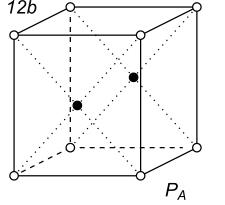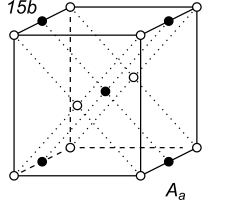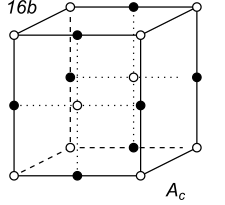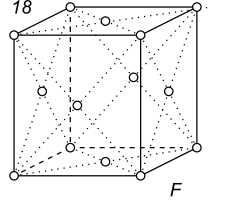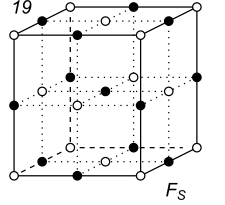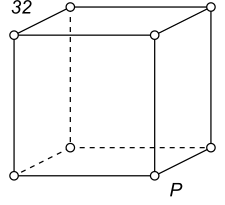Description
Magnetic space groups
The magnetic space groups can be placed into three categories. First, the 230 colorless groups contain only spatial symmetry, and correspond to the crystallographic space groups. Then there are 230 grey groups, which are invariant under antisymmetry. Finally are the 1191 black-white groups, which contain the more complex symmetries. There are two common conventions for giving names to the magnetic space groups. They are Opechowski-Guccione (named after Wladyslaw Opechowski and Rosalia Guccione) [15] and Belov-Neronova-Smirnova (named after Nikolay Vasilyevich Belov, Nina Nikolaevna Neronova and Tamara Serafimovna Smirnova, then Kuntsevich). [16] [10] For colorless and grey groups, the conventions use the same names, but they treat the black-white groups differently. A full list of the magnetic space groups (in both conventions) can be found both in the original papers, and in several places online. [17] [18] [19]
| Type | Name | Number of groups | Description |
|---|---|---|---|
| Type I | Colorless groups | 230 | Ordinary crystallographic space groups, without any additional symmetry. |
| Type II | Grey groups | 230 | Space groups, with an additional anti-symmetry version of every symmetry operation. |
| Type III | Black-White groups (ordinary Bravais lattices) | 674 | Space groups, with additional anti-symmetry versions of half of the symmetry operations. |
| Type IV | Black-White groups (black-white Bravais Lattices) | 517 | Space groups, with additional combined spatial translation-time reversal symmetry. |
The types can be distinguished by their different construction. [20] Type I magnetic space groups, are identical to the ordinary space groups,.
Type II magnetic space groups, , are made up of all the symmetry operations of the crystallographic space group, , plus the product of those operations with time reversal operation, . Equivalently, this can be seen as the direct product of an ordinary space group with the point group .
Type III magnetic space groups, , are constructed using a group , which is a subgroup of with index 2.
Type IV magnetic space groups, , are constructed with the use of a pure translation, , which is Seitz notation [21] for null rotation and a translation, . Here the is a vector (usually given in fractional coordinates) pointing from a black colored point to a white colored point, or vice versa.
Magnetic point groups
The following table lists all of the 122 possible three-dimensional magnetic point groups. This is given in the short version of Hermann–Mauguin notation in the following table. Here, the addition of an apostrophe to a symmetry operation indicates that the combination of the symmetry element and the antisymmetry operation is a symmetry of the structure. There are 32 Crystallographic point groups, 32 grey groups, and 58 magnetic point groups. [22]
| Crystallographic point groups | Grey point groups | Magnetic point groups | ||||
|---|---|---|---|---|---|---|
| 1 | 1' | |||||
| 1 | 11' | 1' | ||||
| 2 | 21' | 2' | ||||
| m | m1' | m' | ||||
| 2/m | 2/m1' | 2'/m' | 2/m' | 2'/m | ||
| 222 | 2221' | 2'2'2 | ||||
| mm2 | mm21' | m'm'2 | 2'm'm | |||
| mmm | mmm1' | mm'm' | m'm'm' | mmm' | ||
| 4 | 41' | 4' | ||||
| 4 | 41' | 4' | ||||
| 4/m | 4/m1' | 4'/m | 4/m' | 4'/m' | ||
| 422 | 4221' | 4'22' | 42'2' | |||
| 4mm | 4mm1' | 4'mm' | 4m'm' | |||
| 42m | 42m1' | 4'2m' | 4'm2' | 42'm' | ||
| 4/mmm | 4/mmm1' | 4'/mmm' | 4/mm'm' | 4/m'm'm' | 4/m'mm | 4'/m'm'm |
| 3 | 31' | |||||
| 3 | 31' | 3' | ||||
| 32 | 321' | 32' | ||||
| 3m | 3m1' | 3m' | ||||
| 3m | 3m1' | 3m' | 3'm' | 3'm | ||
| 6 | 61' | 6' | ||||
| 6 | 61' | 6' | ||||
| 6/m | 6/m1' | 6'/m' | 6/m' | 6'/m | ||
| 622 | 6221' | 6'22' | 62'2' | |||
| 6mm | 6mm1' | 6'mm' | 6m'm' | |||
| 6m2 | 6m21' | 6'2m' | 6'm2' | 6m'2' | ||
| 6/mmm | 6/mmm1' | 6'/m'mm' | 6/mm'm' | 6/m'm'm' | 6/m'mm | 6'/mmm' |
| 23 | 231' | |||||
| m3 | m31' | m'3' | ||||
| 432 | 4321' | 4'32' | ||||
| 43m | 43m1' | 4'3m' | ||||
| m3m | m3m1' | m3m' | m'3'm' | m'3'm | ||
The magnetic point groups which are compatible with ferromagnetism are colored cyan, the magnetic point groups which are compatible with ferroelectricity are colored red, and the magnetic point groups which are compatible with both ferromagnetism and ferroelectricity are purple. [23] There are 31 magnetic point groups which are compatible with ferromagnetism. These groups, sometimes called admissible, leave at least one component of the spin invariant under operations of the point group. There are 31 point groups compatible with ferroelectricity; these are generalizations of the crystallographic polar point groups. There are also 31 point groups compatible with the theoretically proposed ferrotorodicity. Similar symmetry arguments have been extended to other electromagnetic material properties such as magnetoelectricity or piezoelectricity. [24]
The following diagrams show the stereographic projection of most of the magnetic point groups onto a flat surface. Not shown are the grey point groups, which look identical to the ordinary crystallographic point groups, except they are also invariant under the antisymmetry operation.
Black-white Bravais lattices
The black-white Bravais lattices characterize the translational symmetry of the structure like the typical Bravais lattices, but also contain additional symmetry elements. For black-white Bravais lattices, the number of black and white sites is always equal. [25] There are 14 traditional Bravais lattices, 14 grey lattices, and 22 black-white Bravais lattices, for a total of 50 two-color lattices in three dimensions. [26]
The table shows the 36 black-white Bravais lattices, including the 14 traditional Bravais lattices, but excluding the 14 gray lattices which look identical to the traditional lattices. The lattice symbols are those used for the traditional Bravais lattices. The suffix in the symbol indicates the mode of centering by the black (antisymmetry) points in the lattice, where s denotes edge centering.
Magnetic superspace groups
When the periodicity of the magnetic order coincides with the periodicity of crystallographic order, the magnetic phase is said to be commensurate, and can be well-described by a magnetic space group. However, when this is not the case, the order does not correspond to any magnetic space group. These phases can instead be described by magnetic superspace groups, which describe incommensurate order. [30] This is the same formalism often used to describe the ordering of some quasicrystals.






















































































































